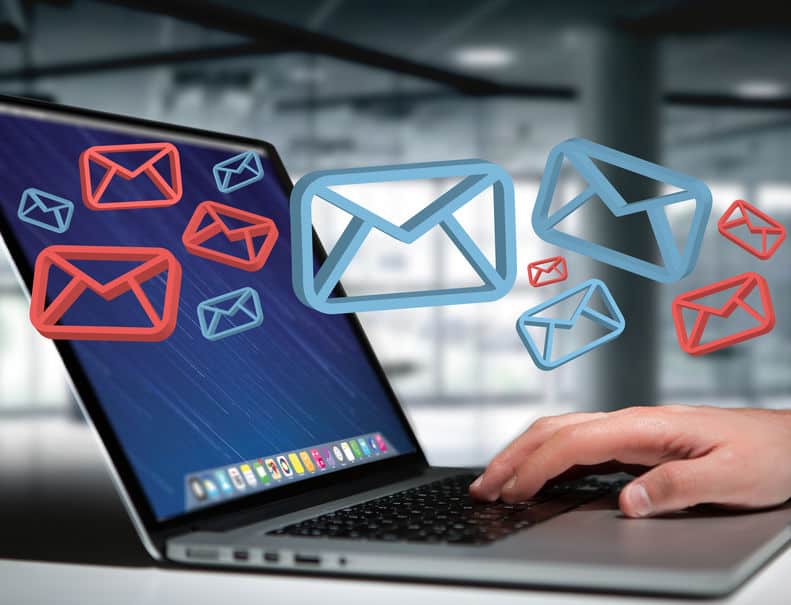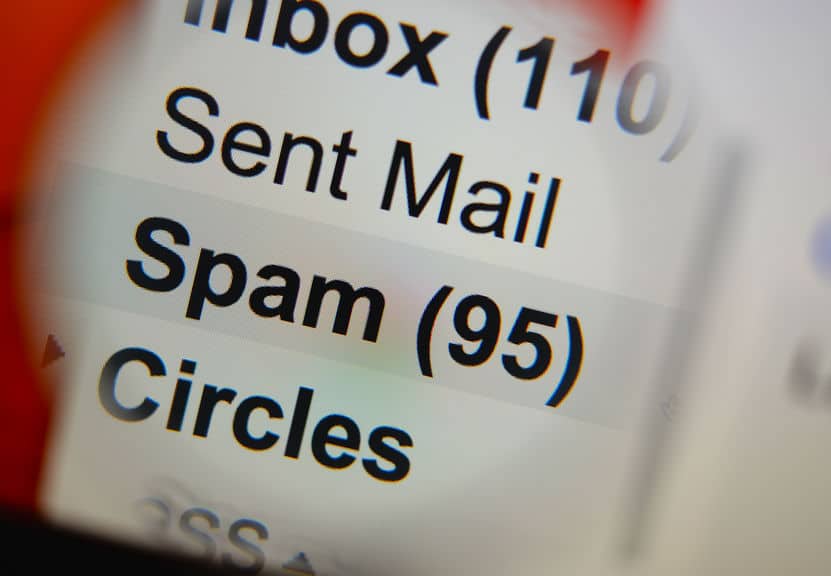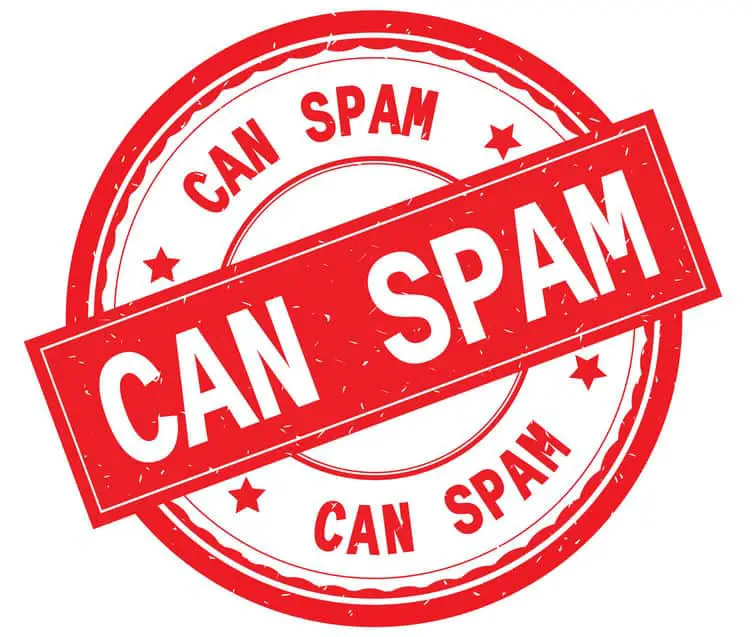There are few things more frustrating than sending an important email to a colleague or client, waiting for the response, and waiting…and waiting. You need to hear back, so you finally decide to call and see what the deal is, only to find out that the recipient never received your message. He or she checks the spam folder, and there’s your email, buried with all the other junk.
What are some common reasons that work email goes to spam? While there are dozens of potential reasons that your work email is being directed to the recipient’s spam folder, the cause is most likely related to one of the following six issues:
- No prior recipient engagement
- Emails don’t get opened frequently
- You abuse CC and BCC
- Low recipient mailbox usage
- Poorly worded subject
- Body copy contains no identifiable information
Your emails can stay out of the spam folder by using the following suggestions provided for each reason. However, depending on the nature of your work, your emails may be getting flagged due to non-compliance with the CAN-SPAM Act, so you may need to check and make sure that if your work contains a marketing element, you are following proper opt-in guidelines.
Common Reasons Work Email Goes to Spam and How to Fix It
Even with the best of intentions, it is possible for a recipient’s webmail provider to detect something fishy with your email and send it to spam. Use the following list of reasons to pinpoint the cause of your messages being redirected and follow the suggested steps to get your address cleared.
Reason Number One: No Prior Recipient Engagement
Your work email is much more likely to get sent to spam if the recipient’s webmail provider does not recognize your address. If you have had no prior e-mail interaction with the recipient, the chances are much greater that your initial message will get marked as spam, especially if your email address ends in .com or .net.
How to fix it: Try to get your intended recipient to email you first, and then respond to his or her message. This will make it easy for the webmail provider to see that the recipient desires contact with your email address, making it extremely unlikely that any of your future work emails coming from the same address will ever get flagged as spam.
While this is a best practice, when using work email to communicate with colleagues, it may not be realistic to expect clients to email you first.
If you are marketing to potential customers through email for the first time, try to make sure that the client has made prior contact with your company website. If they have made a purchase, filled out a web form, or opted-in to your email, your communications should safely land in their inbox.
Reason Number Two: Your Emails Don’t Get Opened Frequently

The leading webmail providers have algorithms for tracking the frequency with which recipients open emails coming from addresses similar to yours.
Simply put: If emails sent from your address have a high “click, delete” rate without ever being opened, you can end up as spam. This is because, based on that history, the provider is led to believe that recipients view your messages as spam and will treat subsequent emails as such.
This is a major problem for young companies that have little history of sending emails through their websites. It is widely accepted that .edu and .gov e-mails are the least likely to get marked as spam because they originate from trusted institutions that have a long history of sending and opening emails within their network.
How to fix it: If your company website and/or email address is young and unestablished, remember this: Don’t send mass marketing emails right off the bat.
What Open Rate is Considered Too Low?
If emails coming from your address are consistently below the 22-percent average open rate benchmark, this can pigeonhole your address into a spam crevice that may be difficult to emerge from. Even if your recipient email addresses have been obtained legitimately.
How to avoid this: For young companies with young e-mail addresses, it is best to establish a solid relationship (of send, open, receive and reply) with other destinations before attempting to mass market via email.
Reason Number Three: You Abuse CC and BCC
It is really annoying to receive emails that show you as just one of 500 recipients on a mailing list. It is even more annoying to get replies that do not concern you from a good majority of recipients on this list. For this reason, CC and BCC exist to serve.
However, while recipients may appreciate not being listed among hundreds of other addresses that they do not recognize, their webmail providers are more likely to mark messages with high CC and BCC volume as spam, believing that the message is originating from an unsolicited mailing list.
How to fix it: If you’re one of those people who likes to copy every single person in your organization on every single email, you might want to reconsider, especially until you’ve built up some equity as a trustworthy source.
People tend to delete messages they’re CCed on without even looking, and as was addressed in reason number two, this will hurt your open rate, which will increase the likelihood that webmail providers mark your messages as spam.
While CC and BCC are helpful and necessary in a work environment, it is prudent not to overuse them, maintaining a solid track record of one-to-one sender and receiver exchanges to balance those times when you need to CC or BCC a larger email blast.
Reason Number Four: Low Recipient Mailbox Usage
Just as webmail providers have algorithms for checking the rate at which your emails get opened, they also have methods for checking out the activity level of the addresses you’re sending to.
In other words, if webmail providers start to detect that you’re emailing to addresses that have been inactive for long periods, your message is likely to get marked as spam.
How to fix it: First and foremost, make sure that all email addresses are entered correctly before hitting send. A simple typo such as “.co” instead of “.com” can cause your email to sit unopened in an unattended inbox or get bounced back as undeliverable, either of which heightens the likelihood that your future emails will get red-flagged as spam.
In addition, make sure you are constantly keeping your recipient records up-to-date. Some best practices may include:
- Do a monthly check and scrub of your email lists – most companies have software that tracks the open and engagement rates of the sent emails. If you have certain addresses and/or lists that are not performing well, you may want to consider suspending further blasts until you are certain that you’re sending to active accounts.
- Encourage the best/preferred email address from clients – if you have lived through the .com boom and everything that has come after, there is a good chance you have about 10 different email accounts from different times and different facets of your life. Make sure that you are encouraging clients to provide you with the account that they check most frequently.
- Get frequent updates from colleagues – studies have shown that millennials will change jobs, on average, seven times over the course of their professional careers. Make sure that you’re touching base with everyone in your professional circle to ensure your emails don’t sit unopened in the inbox of a job they left last year.
Reason Number Five: Poorly Worded Subject
Nailing the subject line may be arguably the most important aspect of achieving email success. As recipients are likely to take less than two seconds in considering your subject before making the decision as to whether to open or delete your message, it is vital that your subject line be clear, concise, and highlight the importance of your message.
Some examples of ineffective subjects that are likely to never get opened, heightening the risk that your future emails get marked as spam, include:
- Using complete sentences in your subject line – save your complete sentences for the body of your email. As crazy as it seems, people just do not have the attention span to read an entire sentence when scrolling their inbox. In addition, the lack of capital letters will make it difficult for your message to stand out.
- One-word subjects with an emoticon or exclamation – while short subject lines are generally much better than wordy subjects, one-word subjects may come across as unprofessional. Subjects like “Greetings :)” or “Hi!” may seem friendly, but they are associated with services that frequently see their emails deleted without being opened.
- All caps – it is important to use capitals in your subject line to catch the attention of the recipient, but all caps reeks of unsolicited marketing and is a sure way to put your message at greater risk of deletion prior to being opened.

While the aforementioned subject lines are spam risks in that they have an increased likelihood of never being opened, killing your open percentage and putting future messages at risk of getting flagged, there are some other subject lines that can mislead recipients into opening them.
In addition to being in violation of the CAN-SPAM Act, which could lead to financial penalties, these types of emails will likely be marked as spam once the recipient realizes they were misled, putting your address at major risk of always being directed to the spam folder. Some examples of misleading subjects include:
- “Free Pizza in the Conference Room” – this becomes problematic when the body has nothing to do with pizza and is actually a report that you want your colleagues to read. While a subject like this may seem like a funny joke, if you are in a large organization where not everyone knows you, you probably don’t want to run the risk of getting flagged.
- “RE: Human Resources Protocol” – as mentioned in an earlier section, getting your recipients engaged with your messages is essential in establishing credibility. By falsely putting “RE” in the subject line, you make the recipient believe he or she previously communicated with you, a surefire way to get flagged once the body reveals otherwise.
- “Thanks for Participating” – there is nothing wrong with this subject–as long as the recipient actually participated. In today’s busy world of remote business and online surveys, it is easy to lose track of everything we do, so to thank a recipient for something he or she never took part in is an unethical way to induce email engagement.
How to fix it: When sending email for work, and especially when using email communication with a new recipient, it is best to keep the subject line between 16 and 41 characters. Important words should be capitalized, like the title of a book, and the subject should convey an accurate depiction of the important information contained in the body of the email.
Norms can differ among industries, so it is important to understand what is acceptable in your line of work and have an honest appraisal of your credibility as a sender. Emojis can be more effective than text, especially among a younger audience, so if you want to include emojis in your subject line, make sure they are used professionally and will be received favorably.
Reason Number Six: Body Contains No Identifiable Information
It can be annoying when you try to log into one of your many online accounts, and you get redirected to a screen asking you to identify all pictures that contain traffic lights?
Unfortunately, such diversions have become necessary safety precautions, as unsolicited bots have figured out creative ways of making their unwanted presence felt in contemporary society.
And just like you don’t want nameless bots trying to figure out the password to your Amazon account, you don’t want them sending you emails about how to lose 50 pounds in three weeks, either.
It is not advisable to open the emails in your spam box. As we mentioned, recipient engagement is a great way to get future emails directed from spam to your inbox. However, if you were to do so, you’d find that the vast majority of spam emails are sent without a signature, an office phone number, or a physical address.
Webmail providers are able to scan incoming emails for this identifiable information, and those emails from nameless bots are quickly directed to the spam folder. Therefore, if you have the habit of quickly typing the body of your emails and sending them off without a proper valediction establishing your credibility, there is an increased chance your message will be flagged.
How to fix it: While it is not a good idea to send super personal information, such as social security or credit card numbers, via email lacking the proper encryption, you are going to want to include some information that establishes you as a credible, professional person within the body of your message.
Many businesses have the company address embedded in the template of employee email, which is a great first step. However, if your company does not, you will want to make sure that all emails you send include:
- Your name
- The physical address of your business headquarters
- Office phone number (optional, but highly recommended)
Most webmail software allows users to set up their signature in the settings. This is a great way to ensure that all of the above pertinent information is included whenever a new email is composed without the sender having to manually enter it every time.
Pro-tip: On the subject of information you must include, if you are using your work email for marketing purposes, do not forget the unsubscribe link. And if you are sending to an international audience, you must abide by the EU’s General Data Protection Regulation, or GDPR. Client privacy and opt-in is increasingly important in today’s world.
Understanding the CAN-SPAM Act

Depending on the nature of your work, you will need to have a thorough understanding of the CAN-SPAM Act. Specifically, if you are involved in any mass marketing through email, then you will need to give your recipients clear instructions for subscribing and opting out of all future emails.
The CAN-SPAM Act can carry some heavy criminal penalties for violators. A few of the activities the CAN-SPAM Act aims to prevent include:
- Deceptive headers and subject lines
- Failure to promptly stop emailing recipients who have opted out
- Not identifying marketing emails as such
- Lack of control of agencies emailing on your company’s behalf
A Checklist for Keeping Work Email Out of Spam
Due to the low cost of email communication and the outstanding returns email marketing campaigns have proven to produce, email use has proliferated over the years to include not only legitimate messages but questionable ones as well. As such, webmail providers have heightened their surveillance for spam, the “junk mail” of the Internet.
There are a multitude of reasons your work emails could be sent to recipients’ spam folders, but if the following steps are taken with your account, it is highly unlikely that your messages will be relegated to the dark depths of spam folder oblivion:
- Establish prior engagement with your recipients
- Ensure a high open-rate in the early days of your account
- Don’t abuse CC and BCC
- Send only to active recipient accounts
- Word your subjects precisely and professionally
- Include some identifiable information
